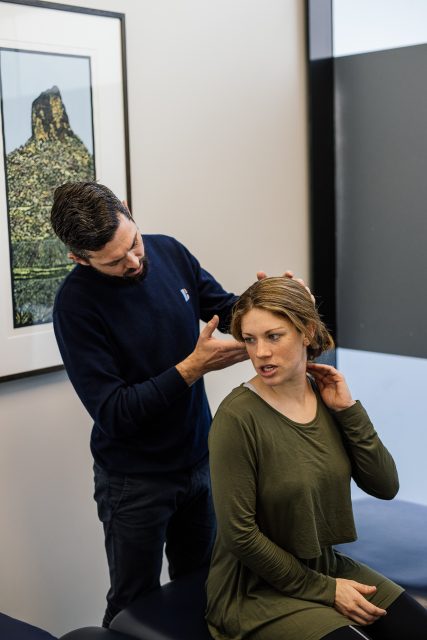Myofascial neck pain, also known as postural neck pain, is a common condition that affects many people. It is caused by the tightening and inflammation of the muscles and connective tissue (fascia) in the neck and shoulders. This can result in pain, stiffness, and limited range of motion in the affected area.
There are many potential causes of myofascial neck pain, including poor posture, repetitive motions, and emotional stress. Sitting for long periods of time at a desk or computer, carrying heavy bags, and using a phone or tablet for extended periods can also contribute to the development of this condition.
Symptoms of myofascial neck pain can include a dull or sharp pain in the neck and shoulders, stiffness, and difficulty turning the head. The pain may also radiate down the arms or into the upper back.
At Range Physio, we use a variety of techniques to alleviate myofascial neck pain. These may include (i) Soft tissue mobilization and massage, (ii) Stretching and strengthening exercises, (iii) Postural education and retraining, and (iv) Dry needling.
In addition to these physiotherapy techniques, there are also self-management strategies that can help alleviate myofascial neck pain and prevent it from recurring. These include:
Maintaining good posture: This can help reduce strain on the neck and shoulders and prevent muscle tension from developing.
Set up a good work desk environment: See our top 10 ergonomic tips to help good posture – https://www.range.physio/ergonomic-tips/
Taking regular breaks: If you spend a lot of time sitting at a desk or computer, make sure to take regular breaks to stretch and move your body.
Avoiding repetitive motions: Try to vary your activities and take frequent breaks if you perform repetitive motions, such as typing or using a mouse.
Stretching: Incorporating stretching exercises into your daily routine can help to loosen tight muscles and improve flexibility in the neck and shoulders.
Reducing stress: Emotional stress can contribute to the development of myofascial neck pain. Practicing stress-reducing techniques such as yoga, meditation, or deep breathing can help to alleviate muscle tension and reduce pain.
In most cases, myofascial neck pain can be effectively managed with physiotherapy. However, it is important to address the underlying cause of the pain and to make lifestyle changes that will help to prevent recurrence. With the right treatment and management, most people with myofascial neck pain can return to normal activities and enjoy a good quality of life.
We recommend applying the 5 stages of rehab to myofascial neck pain:
1 – Pain – Myofascial neck pain often responds well to pain relieving techniques such as massage, heat pack and gentle stretching.
2 – Range of Motion – Tightness through muscles and fascia in the neck can often cause movement limitations. Release work, contract-relax exercises, and gentle stretches typically work well to help restore a normal range of motion.
3- Motor control – Posture and load distribution are often key contributors to myofascial neck pain. Gaining postural awareness and control, and appropriate load distribution can allow for effective strengthening of the neck and upper shoulders, facilitating a return to activities that create a higher demand on the neck region without the return of pain.
4 – Strengthen – “Strengthen to lengthen” is often the way forward with persistent or recurrent myofascial pain. Strengthening the neck muscles and facia to tolerate the required loads will allow full function without the return of tightness and pain.
5 – Maintain – A strengthening and stretching program will allow management gains to be maintained into the future with hopefully only fleeting recurrence. Treatment and pain management strategies would only be implemented when required.


